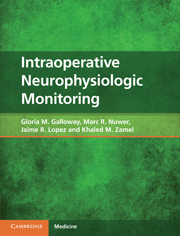15 results
Which patients benefit from adding short-term psychodynamic psychotherapy to antidepressants in the treatment of depression? A systematic review and meta-analysis of individual participant data
-
- Journal:
- Psychological Medicine / Volume 53 / Issue 13 / October 2023
- Published online by Cambridge University Press:
- 21 November 2022, pp. 6090-6101
-
- Article
-
- You have access
- Open access
- HTML
- Export citation
Contributors
-
-
- Book:
- Funerary Practices and Models in the Ancient Andes
- Published online:
- 05 February 2015
- Print publication:
- 02 March 2015, pp ix-x
-
- Chapter
- Export citation
Dedication
-
- Book:
- Intraoperative Neurophysiologic Monitoring
- Published online:
- 05 September 2013
- Print publication:
- 28 October 2010, pp v-vi
-
- Chapter
- Export citation
11 - Cranial nerve monitoring
-
-
- Book:
- Intraoperative Neurophysiologic Monitoring
- Published online:
- 05 September 2013
- Print publication:
- 28 October 2010, pp 109-141
-
- Chapter
- Export citation
Index
-
- Book:
- Intraoperative Neurophysiologic Monitoring
- Published online:
- 05 September 2013
- Print publication:
- 28 October 2010, pp 236-241
-
- Chapter
- Export citation

Intraoperative Neurophysiologic Monitoring
-
- Published online:
- 05 September 2013
- Print publication:
- 28 October 2010
12 - Peripheral nerve monitoring:
-
-
- Book:
- Intraoperative Neurophysiologic Monitoring
- Published online:
- 05 September 2013
- Print publication:
- 28 October 2010, pp 142-162
-
- Chapter
- Export citation
Intraoperative Neurophysiologic Monitoring - Half title page
-
- Book:
- Intraoperative Neurophysiologic Monitoring
- Published online:
- 05 September 2013
- Print publication:
- 28 October 2010, pp i-ii
-
- Chapter
- Export citation
14 - Intraoperative neurophysiologic monitoring of vascular disorders
-
-
- Book:
- Intraoperative Neurophysiologic Monitoring
- Published online:
- 05 September 2013
- Print publication:
- 28 October 2010, pp 172-195
-
- Chapter
- Export citation
16 - Interpreting and reporting the neurophysiologic data to the surgical team:
-
-
- Book:
- Intraoperative Neurophysiologic Monitoring
- Published online:
- 05 September 2013
- Print publication:
- 28 October 2010, pp 207-220
-
- Chapter
- Export citation
Copyright page
-
- Book:
- Intraoperative Neurophysiologic Monitoring
- Published online:
- 05 September 2013
- Print publication:
- 28 October 2010, pp iv-iv
-
- Chapter
- Export citation
Contents
-
- Book:
- Intraoperative Neurophysiologic Monitoring
- Published online:
- 05 September 2013
- Print publication:
- 28 October 2010, pp vii-viii
-
- Chapter
- Export citation
Intraoperative Neurophysiologic Monitoring - Title page
-
-
- Book:
- Intraoperative Neurophysiologic Monitoring
- Published online:
- 05 September 2013
- Print publication:
- 28 October 2010, pp iii-iii
-
- Chapter
- Export citation
Acknowledgments
-
- Book:
- Intraoperative Neurophysiologic Monitoring
- Published online:
- 05 September 2013
- Print publication:
- 28 October 2010, pp x-x
-
- Chapter
- Export citation
Contributors
-
-
- Book:
- The Cambridge Dictionary of Christianity
- Published online:
- 05 August 2012
- Print publication:
- 20 September 2010, pp xi-xliv
-
- Chapter
- Export citation

